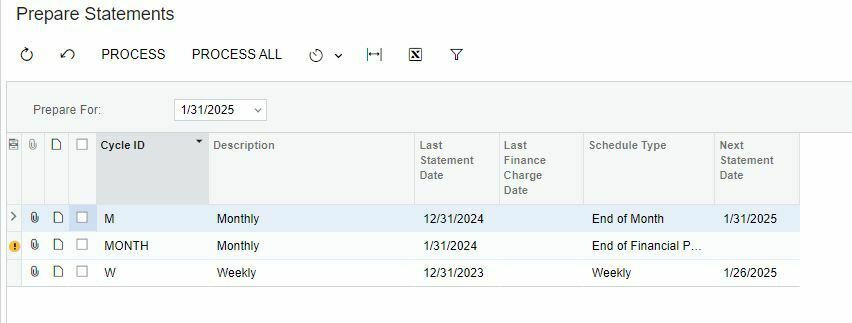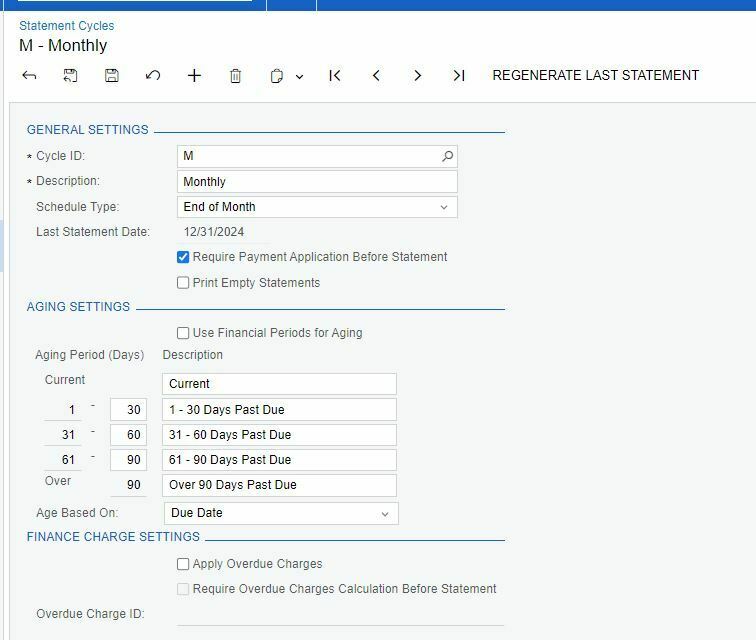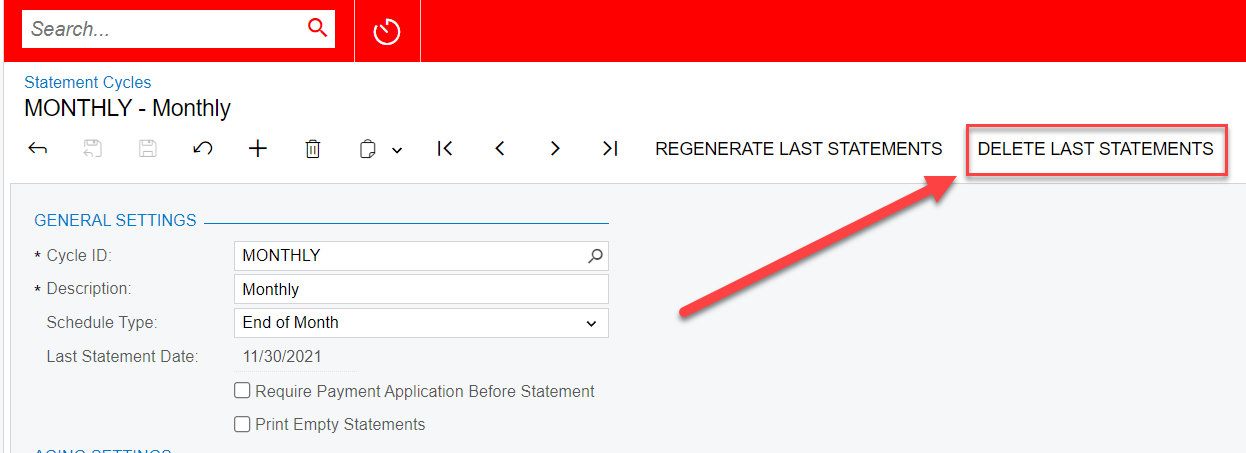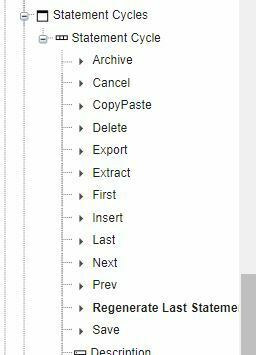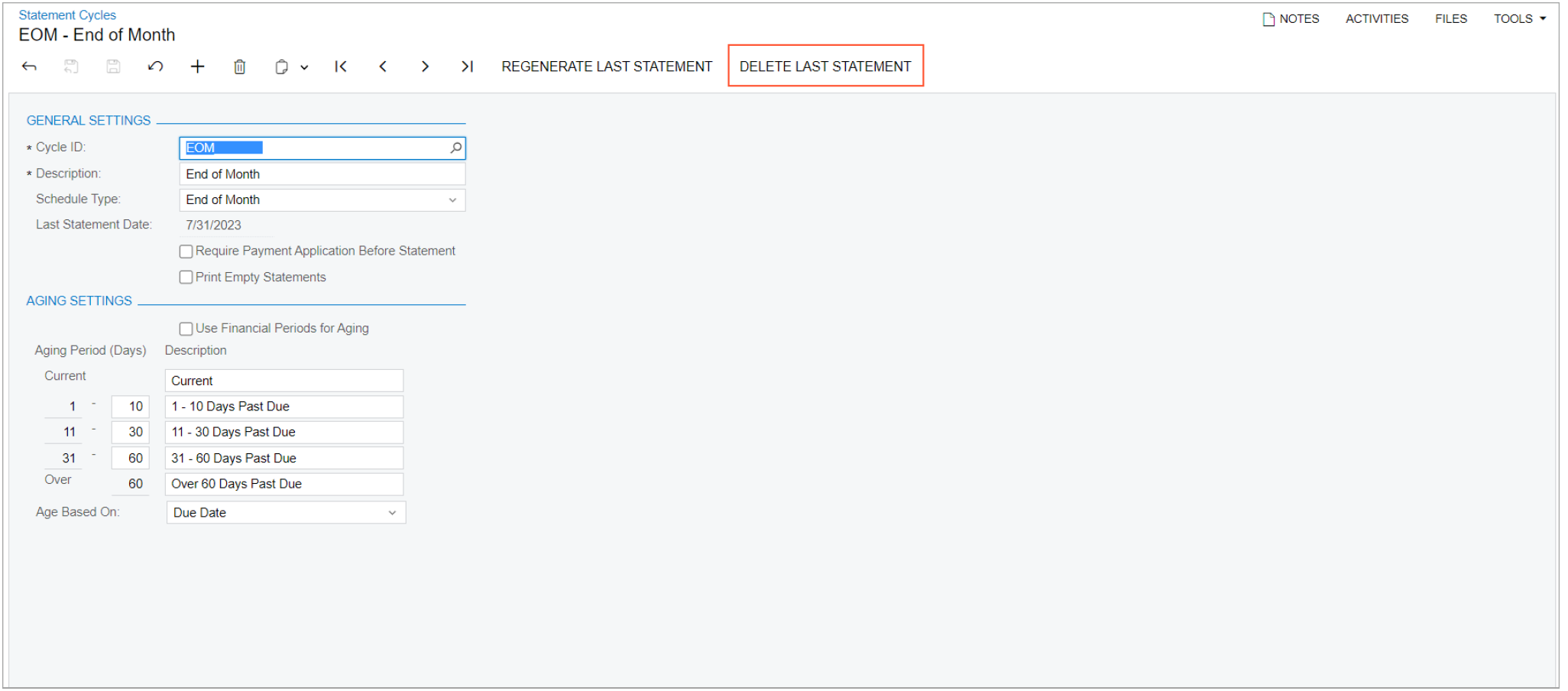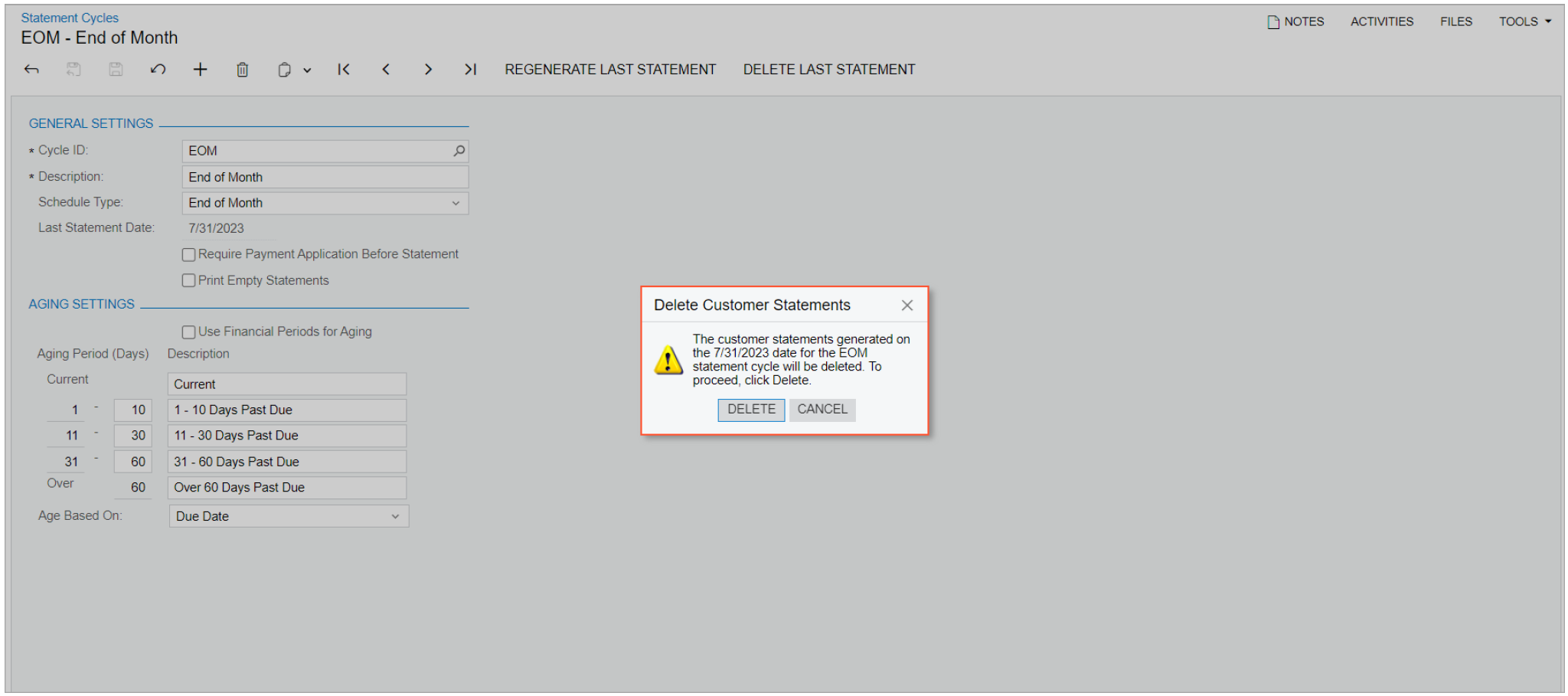Alternatively, if you’re on a version that doesn’t have this button yet, you’ll need access to the database to run the following query, or open a support ticket and have them run this query with the appropriate values for:
@LastStmtDate , @CycleID, @CompanyID
Here’s the script:
/*The script removes statements and all associated data for the specified period.
Also corrected the wrong StatementLastDate of customers.*/
DECLARE @CycleID as varchar(10);
DECLARE @LastStmtDate as varchar(10);
DECLARE @CompanyID as int;
--=============================================
--SET YOUR PARAMETERS HERE:
SET @CycleID = 'EOM'; -- put here statement cycle
SET @LastStmtDate = '2023-12-31'; -- put here latest statement date you want to rollback
SET @CompanyID = 2; -- put here companyid
--=============================================
UPDATE ARStatementCycle
SET LastStmtDate = @LastStmtDate
WHERE
ARStatementCycle.StatementCycleID = @CycleID
AND CompanyID = @CompanyID
;
--find all the statements to remove
SELECT
ARStatement.CompanyID,
ARStatement.BranchID,
ARStatement.CustomerID,
ARStatement.StatementDate,
ARStatement.CuryID,
ARStatement.StatementCycleID,
ARStatementCycle.LastStmtDate
INTO #ARStatement
FROM
ARStatement
INNER JOIN ARStatementCycle
ON ARStatementCycle.CompanyID = ARStatement.CompanyID
AND ARStatementCycle.StatementCycleID = ARStatement.StatementCycleID
WHERE
ARStatement.CompanyID = @CompanyID
AND ARStatementCycle.StatementCycleID = @CycleID
AND ARStatement.StatementDate > @LastStmtDate
UNION ALL
--Customer with the appropriate StatementCycleID, but he has a statement for another StatementCycleID in the generated period.
--He is the parent with appropriate parameters to generate the statement
SELECT
ARStatement.CompanyID,
ARStatement.BranchID,
ARStatement.CustomerID,
ARStatement.StatementDate,
ARStatement.CuryID,
ARStatement.StatementCycleID,
@LastStmtDate
FROM
Customer
INNER JOIN ARStatement
ON ARStatement.CompanyID = Customer.CompanyID
AND ARStatement.CustomerID = Customer.BAccountID
AND ARStatement.StatementCycleId != customer.StatementCycleId
AND Customer.StatementCycleId = @CycleID
AND Customer.StatementLastDate > @LastStmtDate
AND Customer.CompanyID = @CompanyID
AND ARStatement.StatementDate > @LastStmtDate
INNER JOIN Customer as CustomerMaster
ON CustomerMaster.BAccountID = Customer.StatementCustomerID
AND CustomerMaster.CompanyID = Customer.CompanyID
AND (CustomerMaster.StatementLastDate <= @LastStmtDate
OR CustomerMaster.StatementLastDate IS NULL)
;
SELECT
ARStatementDetail.CompanyID,
ARStatementDetail.BranchID,
ARStatementDetail.CustomerID,
ARStatementDetail.CuryID,
ARStatementDetail.DocType,
ARStatementDetail.RefNbr,
ARStatementDetail.StatementDate,
#ARStatement.LastStmtDate
INTO #ARStatementDetails
FROM
ARStatementDetail
INNER JOIN #ARStatement
ON ARStatementDetail.CompanyID = #ARStatement.CompanyID
AND ARStatementDetail.BranchID = #ARStatement.BranchID
AND ARStatementDetail.CustomerID = #ARStatement.CustomerID
AND ARStatementDetail.StatementDate = #ARStatement.StatementDate
AND ARStatementDetail.CuryID = #ARStatement.CuryID
;
SELECT
ARStatementAdjust.CompanyID,
ARStatementAdjust.BranchID,
ARStatementAdjust.CustomerID,
ARStatementAdjust.StatementDate,
ARStatementAdjust.CuryID,
ARStatementAdjust.AdjdDocType,
ARStatementAdjust.AdjdRefNbr,
ARStatementAdjust.AdjgDocType,
ARStatementAdjust.AdjgRefNbr,
ARStatementAdjust.AdjNbr,
#ARStatement.LastStmtDate
INTO #ARStatementAdjust
FROM
ARStatementAdjust
INNER JOIN #ARStatement
ON ARStatementAdjust.CompanyID = #ARStatement.CompanyID
AND ARStatementAdjust.CustomerID = #ARStatement.CustomerID
AND ARStatementAdjust.BranchID = #ARStatement.BranchID
AND ARStatementAdjust.StatementDate = #ARStatement.StatementDate
AND ARStatementAdjust.CuryID = #ARStatement.CuryID
;
--UPDATE ARRegister TABLE:
UPDATE ARRegister
SET ARRegister.StatementDate = #ARStatementDetails.LastStmtDate
FROM
ARRegister
INNER JOIN #ARStatementDetails
ON #ARStatementDetails.CompanyID = ARRegister.CompanyID
AND #ARStatementDetails.BranchID = ARRegister.BranchID
AND #ARStatementDetails.CustomerID = ARRegister.CustomerID
AND #ARStatementDetails.CuryID = ARRegister.CuryID
AND #ARStatementDetails.DocType = ARRegister.DocType
AND #ARStatementDetails.RefNbr = ARRegister.RefNbr
;
--UPDATE ARAdjust TABLE:
UPDATE ARAdjust
SET ARAdjust.StatementDate = #ARStatementAdjust.LastStmtDate
FROM
ARAdjust
INNER JOIN #ARStatementAdjust
ON #ARStatementAdjust.CompanyID = ARAdjust.CompanyID
AND #ARStatementAdjust.AdjdDocType = ARAdjust.AdjdDocType
AND #ARStatementAdjust.AdjdRefNbr = ARAdjust.AdjdRefNbr
AND #ARStatementAdjust.AdjgDocType = ARAdjust.AdjgDocType
AND #ARStatementAdjust.AdjgRefNbr = ARAdjust.AdjgRefNbr
AND #ARStatementAdjust.AdjNbr = ARAdjust.AdjNbr
;
--DELETE FROM ARStatementDetail TABLE:
DELETE ARStatementDetail
FROM
ARStatementDetail
INNER JOIN #ARStatementDetails
ON #ARStatementDetails.CompanyID = ARStatementDetail.CompanyID
AND #ARStatementDetails.BranchID = ARStatementDetail.BranchID
AND #ARStatementDetails.CustomerID = ARStatementDetail.CustomerID
AND #ARStatementDetails.StatementDate = ARStatementDetail.StatementDate
AND #ARStatementDetails.CuryID = ARStatementDetail.CuryID
AND #ARStatementDetails.DocType = ARStatementDetail.DocType
AND #ARStatementDetails.RefNbr = ARStatementDetail.RefNbr
;
--DELETE FROM ARStatementAdjust TABLE:
DELETE ARStatementAdjust
FROM
ARStatementAdjust
INNER JOIN #ARStatementAdjust
ON #ARStatementAdjust.CompanyID = ARStatementAdjust.CompanyID
AND #ARStatementAdjust.BranchID = ARStatementAdjust.BranchID
AND #ARStatementAdjust.CustomerID = ARStatementAdjust.CustomerID
AND #ARStatementAdjust.CuryID = ARStatementAdjust.CuryID
AND #ARStatementAdjust.StatementDate = ARStatementAdjust.StatementDate
AND #ARStatementAdjust.AdjdDocType = ARStatementAdjust.AdjdDocType
AND #ARStatementAdjust.AdjdRefNbr = ARStatementAdjust.AdjdRefNbr
AND #ARStatementAdjust.AdjgDocType = ARStatementAdjust.AdjgDocType
AND #ARStatementAdjust.AdjgRefNbr = ARStatementAdjust.AdjgRefNbr
AND #ARStatementAdjust.AdjNbr = ARStatementAdjust.AdjNbr
;
--DELETE FROM ARStatement TABLE:
DELETE ARStatement
FROM
ARStatement
INNER JOIN #ARStatement
ON #ARStatement.CompanyID = ARStatement.CompanyID
AND #ARStatement.BranchID = ARStatement.BranchID
AND #ARStatement.CustomerID = ARStatement.CustomerID
AND #ARStatement.StatementDate = ARStatement.StatementDate
AND #ARStatement.CuryID = ARStatement.CuryID
;
DROP TABLE #ARStatement;
DROP TABLE #ARStatementDetails;
DROP TABLE #ARStatementAdjust;
--Set StatementLastDate to max StatementDate from all customer's statements:
UPDATE Customer
SET Customer.StatementLastDate = c.MaxStatementDate
FROM
Customer
INNER JOIN
(SELECT
Customer.BAccountID,
Customer.CompanyID,
Customer.StatementLastDate,
MAX(ARStatement.StatementDate) AS MaxStatementDate
FROM
Customer
INNER JOIN ARStatement
ON ARStatement.CompanyID = Customer.CompanyID
AND ARStatement.CustomerID = Customer.BAccountID
WHERE
Customer.CompanyID = @CompanyID
AND Customer.DeletedDatabaseRecord = 0
AND Customer.StatementLastDate > @LastStmtDate
GROUP BY
Customer.BAccountID,
Customer.CompanyID,
Customer.StatementLastDate
HAVING
MAX(ARStatement.StatementDate) != Customer.StatementLastDate) AS c
ON Customer.BAccountID = c.BAccountID
AND Customer.CompanyID = c.CompanyID
AND Customer.StatementLastDate != c.MaxStatementDate
;
--Reset Customer.StatementLastDate for those who have no ARStatement
UPDATE Customer
SET Customer.StatementLastDate = @LastStmtDate
FROM
Customer
LEFT JOIN ARStatement
ON ARStatement.CompanyID = Customer.CompanyID
AND ARStatement.CustomerID = Customer.BAccountID
WHERE
Customer.CompanyID = @CompanyID
AND NOT Customer.StatementLastDate IS NULL
AND ARStatement.CustomerID IS NULL
Hope this helps! :)
